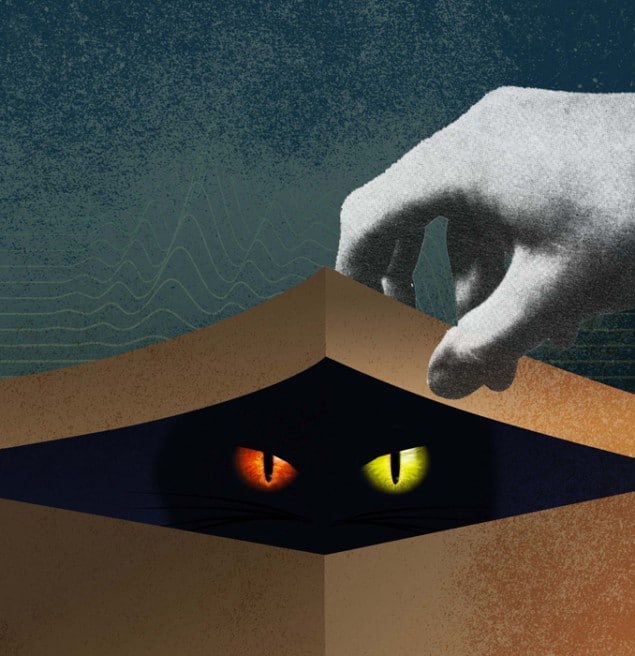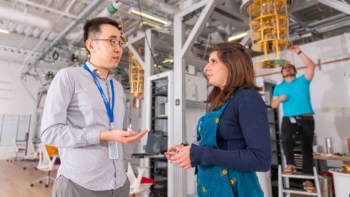
Physicists in the Netherlands say they have manipulated the state of a quantum bit (or qubit) by simply adjusting the strength of the technique they used to measure it. The method, which involves using an ancilla (or helper) qubit and a new technique for “non-demolition” read-out, can be used to “steer” the qubit to the desired state. The work is not only of interest for fundamental physics, but could also find use in future quantum computers and for improving the sensitivity of magnetic-field sensors.
One of the fundamental principles of quantum mechanics is that an object can be in two or more states at the same time. This means that an electron can, for instance, be in two places at once. However, these “superposition” states are never seen in classical, macroscopic objects – as illustrated by the paradox of Schrödinger’s famous thought experiment involving a cat in a sealed box, which clearly could not be both dead and alive at the same time.
Indeed, the very act of trying to find out whether the cat is alive or dead actually changes its state. This act of measuring, through the so-called quantum-mechanical back-action, disturbs the state of a quantum object so that it collapses and behaves like a classical one.
Opening the box
Now, researchers at the Foundation for Fundamental Research on Matter (FOM) and Delft University of Technology say they have succeeded in “opening” the box in which Schrödinger’s cat finds itself by just a small amount. In this way, it is possible to take a “peek” at the cat without destroying its fragile quantum state.
The team, led by Ronald Hanson, replaced the cat with a nitrogen atom in diamond – referred to as a nitrogen-vacancy (NV) centre. This particle carries a nuclear spin that can point up (equivalent to the cat being alive) or down (cat dead). In previous work, the same group showed that it is possible to measure the spin’s orientation by coupling the state of the nucleus to a nearby electron. By varying the strength of the coupling between the nucleus and electron, the researchers we able to actually control the strength of their measurements.
They found that weaker measurements revealed less information but also had less effect on the spin. Analysing a nuclear spin after such a measurement showed that the spin remained in a superposition of two states – albeit a slightly altered superposition.
Steering a spin
Now, Hanson and colleagues have discovered that they can actually “steer” the nuclear spin by applying a series of measurements that vary in strength. Since the outcome of a measurement is not known beforehand, the researchers apply a feedback loop in their experiment. They adapt the strength of a second measurement depending on the outcome of a first, and in this way manoeuvre the nucleus towards a desired superposition state.
To do this, the team uses an “ancilla” qubit, which in this case was the spin of the electron associated with the vacancy of the NV centre. “This ‘ancilla’ qubit helps to partially measure the spin of the nitrogen atom of the NV centre,” explains Delft’s Machiel Blok. The researchers measure the electron’s spin orientation by applying a laser that excites the electron only if its spin is in the up state. The resulting fluorescence signal (bright or dark) reveals the state of the electron: bright means that the electron is in an up state and dark means that it is in a down state.
The measurements and feedback loops developed by the team could be useful for measurement-based quantum computing in the future, say the researchers. “In this particular scheme, a large entangled state is first created between many qubits,” explains Blok. “Actual computation is then performed by sequentially measuring the individual qubits while adjusting the measurement settings depending on the results of previous ones.”
Better magnetic measurements
Furthermore, the NV centre’s electron spin is extremely sensitive to small changes in magnetic field over tiny volumes. As a result, the team’s protocols could be used to make magnetic measurements of biological samples that are more sensitive than current methods based on superconducting quantum interference devices (SQUIDs) or magnetic resonance imaging.
The work is described in Nature Physics and is also available as a preprint on the arXiv server.
- This article first appeared on nanotechweb.org



